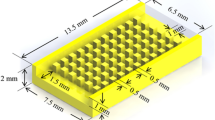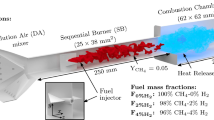Abstract
Wax deposition from a waxy crude oil is modelled in turbulent flow in a pipeline. Molecular diffusion in a thin boundary layer near the pipe wall is taken as the only mechanism responsible for deposition. The model takes into account the ablation, which is a flow-related phenomenon that limits the growth of the deposit. The effect of desaturation of the oil is analyzed as well. Two field cases are presented in which the numerical implementation of the model is in agreement with the experimental data.
Similar content being viewed by others
Abbreviations
- r :
-
Radial coordinate
- z :
-
Longitudinal coordinate
- L :
-
Length of the pipeline
- R :
-
Pipe radius
- R T :
-
Radius of the region where temperature is independent from r
- R m :
-
Radius of the turbulent core
- \({\nu}\) :
-
Radius of the deposition front
- \({\sigma_{\rm d}}\) :
-
Thickness of the deposit
- \({\sigma_{\rm T}}\) :
-
Thermal boundary layer thickness
- \({\sigma_{\rm m}}\) :
-
Momentum boundary layer thickness
- \({\theta_{\rm T}}\) :
-
Ratio \({R_{\rm T}/\nu}\)
- \({\theta_{\rm m}}\) :
-
Ratio \({R_{\rm m}/\nu}\)
- \({\varepsilon_{\rm T}}\) :
-
\({1-\theta_{\rm T}}\)
- \({\varepsilon_{\rm m}}\) :
-
\({1-\theta_{\rm m}}\)
- V :
-
Velocity of the turbulent core
- η:
-
Viscosity
- Q :
-
Volumetric flow rate
- ΔP :
-
Pressure gradient
- \({\tau}\) :
-
Shear stress acting on the turbulent core
- \({\rho}\) :
-
Density
- f :
-
Friction factor
- χ:
-
Surface roughness
- Re :
-
Reynolds number
- T :
-
Temperature in the thermal boundary layer
- T c :
-
Temperature in the region 0 ≤ r ≤ R T
- T e :
-
Temperature of the surroundings
- T w :
-
Temperature at the pipe wall
- T o :
-
Temperature of the oil at the inlet
- T cloud :
-
Cloud point
- c :
-
Specific heat
- k :
-
Heat conductivity
- h :
-
Heat transfer coefficient
- α:
-
\({k/(\rho c)}\)
- μ:
-
k/(h R)
- z f :
-
Longitudinal coordinate after which deposition starts
- z des :
-
Longitudinal coordinate after which the turbulent core becomes unsaturated
- z e :
-
Longitudinal coordinate after which deposition ceases
- z s :
-
Longitudinal coordinate after which deposition ceases because of desaturation
- M tot :
-
Total mass of deposit (oil included)
- M exp :
-
Mass of recovered material
- D :
-
Wax diffusivity
- C s(T):
-
Solubility
- G :
-
Segregated wax concentration
- c :
-
Dissolved wax concentration
- \({\beta}\) :
-
Derivative of solubility w.r.t. temperature
- \({\psi}\) :
-
Solid wax fraction of the deposit
- A :
-
Ablation coefficient
- \({\overrightarrow{j}_{\rm wax}}\) :
-
Dissolved wax mass flux
- \({\overrightarrow{j}_{\rm dep}}\) :
-
Total mass flux
- \({j_{\rm abl}}\) :
-
Ablation rate per unit surface
- \({\overrightarrow{e}_{\rm r}}\) :
-
Unit radial vector
- \({\overrightarrow{e}_{\rm z}}\) :
-
Unit longitudinal vector
- \({\overrightarrow{n}}\) :
-
Unit normal to the deposition front
- \({t_{\rm a}}\) :
-
Characteristic consolidation time
- \({t_{\rm o}}\) :
-
Characteristic deposition time.
References
Azevedo LFA, Teixeira AM (2003) A critical review of the modeling of wax deposition mechanisms. Petrol Sci Technol 21(3 and 4):393–408
Bern PA, Winthers VR, Cairns J (1980) Wax deposition in pipelines. European Offshore Petroleum Conference & Exhibition, London, pp 21–24.
Borghi GB, Correra S, Merlini M., Carniani C (2003) Prediction and scaleup of waxy oil restart behavior. Soci Petrol Engi SPE 80259:1–5
Burger ED, Perkins TK, Striegler JH (1981) Studies of wax deposition in the Trans-Alaska pipeline. J Petrol Technol 33:1075–1086
Correra S, Andrei M, Carniani C (2005) Wax diffusivity: is it a physical property or a pivotable parameter?. Petro Sc & Technol, 21(9):1539–1554
Correra S, Fasano A, Fusi L, Primicerio M, Rosso F (2006) Wax diffusivity under given thermal gradient: a mathematical model, to appear on ZAMM, DOI:2005/0293
Correra S, Fasano A, Fusi L, Primicerio M (2006) Modelling wax diffusion in crude oils: the cold finger device, to appear on J Appl Mathe Model, DOI: 10.1016
Coutinho JAP, Edmonds B, Moorwood T, Szczepanski R, Zhang X (2006) Reliable wax predictions for flow assurance. Energy Fuels 20:1081–1088
Creek JL, Lund HJ, Brill JP, Volk M (1999) Wax deposition in a single phase flow. Fluid Phase Equilibria, 158(1):801–811
Fasano A, Fusi L, Correra S (2004) Mathematical Models for Waxy Crude Oils. Meccanica 39: 441–482
Fasano A, Primicerio M (2005) Temperature driven mass transport in concentrated saturated solutions. Prog Nonlinear Diff Equ Their Appl 61:91–108
Fasano A, Primicero M (2003) Heat and Mass transfer in non-isothermal partially saturated solutions. New Trends in Mathematical Physics. Proceedings of the international meeting Naples, January 24–25, pp 34–44
Hammami A, Ratulowski J, Coutinho JAP, (2003) Cloud points and can we measure or model them. Petrol Sci Technol 21(3 and 4):345–358
Hansen JH, Fredenslund Aa, Pedersen KS, Rnningsen HP (2004) A thermodynamic model for predicting wax formation in crude oils. AIChE J 34(12):1937–1942
Hsu JJC, Santamaria MM, Brubaker JP (1994) Wax deposition of waxy live crudes under turbulent flow conditions. SPE 28480, SPE Annual technical conference and exhibition. New Orleans, LA, September
Kays WM, Crawford ME (1980) Convective Heat and Mass Transfer. McGraw Hill, New York
Lira-Galeana C, Firoozabadi A, Prausnitz JM (1996) Thermodynamics of wax precipitation in petroleum mixtures. AIChE J 42(1):239–248
Nazar SAR, Dabir B, Vaziri H, Islam MR (2001) Experimental and mathematical modeling of wax deposition and propagation in pipes transporting crude oil. SPE 67328: 239–248
Pan H, Firoozabadi A, Fotland P (1997) Pressure and composition effect on wax precipitation: experimental data and model results. SPE Prod Facili J (Nov) 250–258
Perry RH, Green DW, Maloney JO (1999) Perry’s chemical engineers’ handbook. McGraw-Hill, New York
Shock DA, Sudbury JD, Crockett JJ (1955) Studies on the mechanism of paraffin deposition and its control. J petrol Technol 7(9):23–30
Singh P, Venkatesan R, Fogler S (2000) Formation and aging of incipient thin film wax-oil gels. AIChE J 46(5): 1059–1074
Singh P, Venkatesan R, Fogler S (2001) Morphological evolution of thick wax deposits during aging. AIChE J 47(1):6–18
Svendsen JA (1993) Mathematical modeling of wax deposition in oil pipeline system. AIChE J 39(8): 1377–1388
Venkatesan R (2004) The deposit and rheology of organic gels. P.h.D. Thesis, University of Michigan
Author information
Authors and Affiliations
Corresponding author
Additional information
Work performed in the framework of the cooperation between EniTecnologie (Milan) and I2T3 (Florence).
Rights and permissions
About this article
Cite this article
Correra, S., Fasano, A., Fusi, L. et al. Calculating Deposit Formation in the Pipelining of Waxy Crude Oils. Meccanica 42, 149–165 (2007). https://doi.org/10.1007/s11012-006-9028-4
Received:
Accepted:
Published:
Issue Date:
DOI: https://doi.org/10.1007/s11012-006-9028-4




